Top 10 FREE Network Monitors for 2023 – 100% Free Downloads
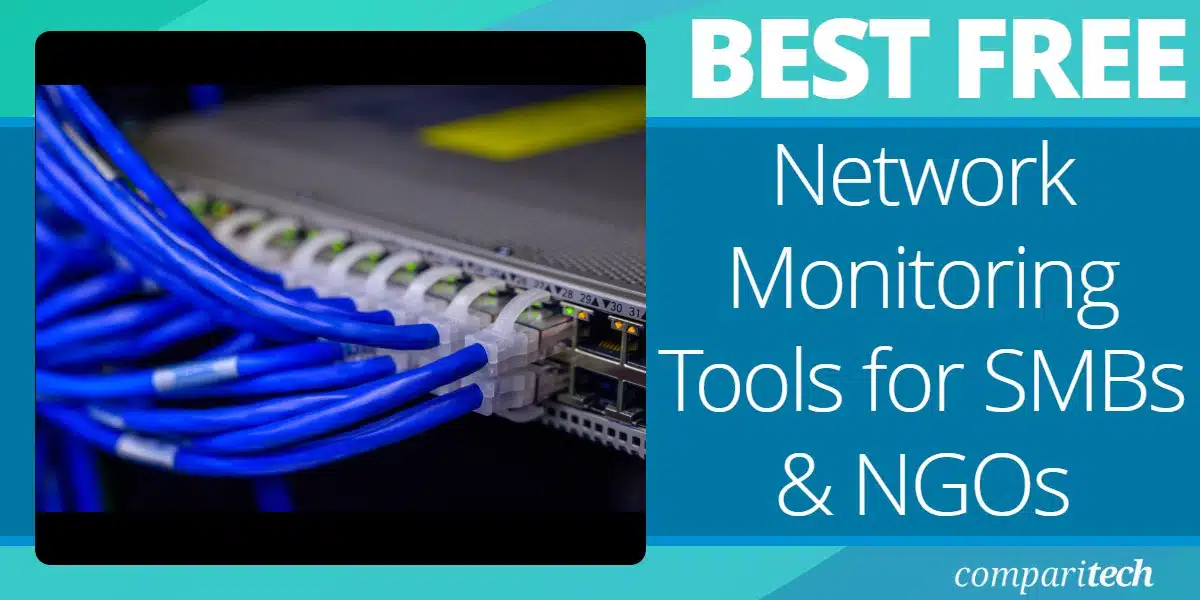
In the past, network monitoring tools were pertinent to the needs of larger organizations. Today, network monitoring suites are a lot more accessible to SMBs, NGOs, non-profits, and smaller organizations in general. Administrators in enterprises of all sizes are on the lookout for network monitoring tools that help to strengthen their online service.
As the technological needs of organizations and consumers have increased, so has the need for network monitoring products. Even small networks can bring out hundreds of connections that need to be monitored. Modern network monitoring tools have the ability to maintain networks, servers, and applications. Having a program capable of juggling the maintenance of these systems helps administrators to stay on top of what is going on.
Here is our list of the best free network monitoring tools:
- SolarWinds ipMonitor Free Edition
EDITOR’S CHOICE
A combined network and server monitor that will discover all of your network assets automatically and continuously monitor them. - Paessler PRTG Network Monitor
(FREE EDITION)
All-in-one network, server, and application monitor that is a collection of sensors. You customize the tool by deciding which sensors to turn on. - Site24x7 Free Server Monitoring
(FREE EDITION)
A cut-down version of the Site24x7 Infrastructure plan that is limited to uptime monitoring. This is a cloud-based service. - ManageEngine OpManager
(FREE TRIAL)
A package of network and server monitoring services that is available in free and paid versions. Installs on Windows Server and Linux.
- Domotz
(FREE TRIAL)
This cloud-based network monitoring service offers a full management and monitoring platform for a fixed price per site.
- LibreNMS This free system has all the hallmarks of a sophisticated paid enterprise network monitor, such as a discovery service and performance alerts. Runs on Linux or Docker.
- Prometheus This flexible data processing tool can be used to assemble a custom network monitoring system. Runs on Windows, Linux, and Darwin.
- Zabbix A free infrastructure monitor that runs on Linux.
- Nagios Core An infrastructure monitor that can be extended by community-created extensions. A free version is called Nagios Core.
- Icinga 2 A free network monitor that is a fork of Nagios Core. Can be enhanced with Nagios extensions.
A network monitoring tool not only frees up time that is spent on tedious administrative tasks but also boosts an administrator’s ability to respond to small issues before they become more complex and problematic.
Mục Lục
Our methodology for selecting free network monitoring tools
We reviewed the market for free network monitoring software and analyzed the options based on the following criteria:
- The option to use the free trial period of paid network monitoring software
- A service that includes graphical representations of network device performance
- A system that uses SNMP to monitor network devices
- A package that can include server and application monitoring
- Nice to have network traffic analysis functions
- Systems that will run on Windows, Linux, or macOS
- A good mix of visual elements and text lists in each screen
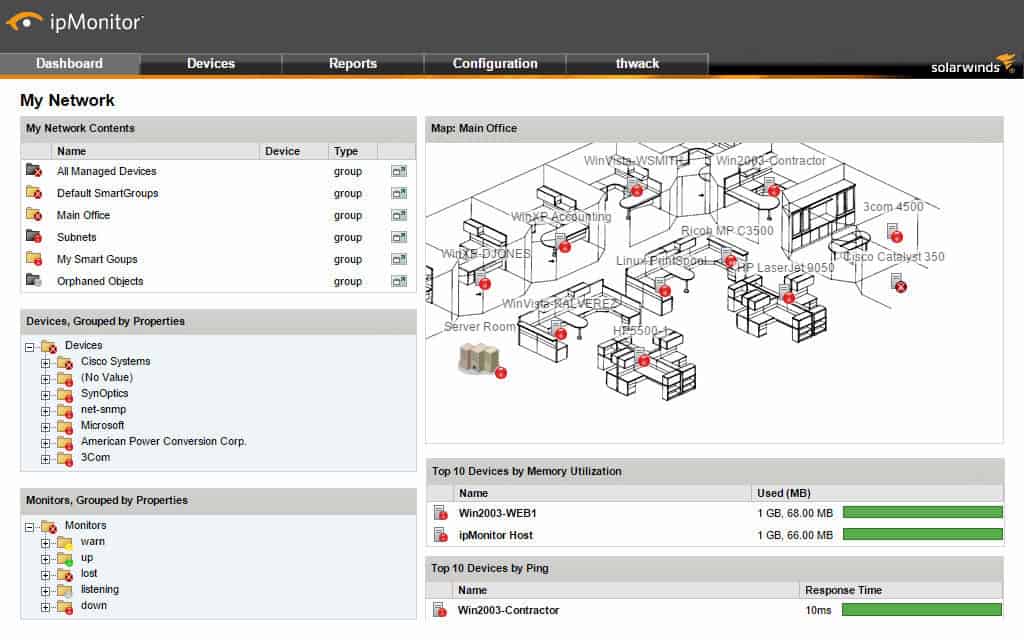 At the number one spot on this list, we have SolarWinds ipMonitor Free Edition. While SolarWinds Network Performance Monitor has drawn lots of attention as one of the most scalable network monitoring solutions on the market, ipMonitor has stood alongside it as a good tool for SMBs. With SolarWinds ipMonitor you can monitor network devices and servers from a centralized location.
At the number one spot on this list, we have SolarWinds ipMonitor Free Edition. While SolarWinds Network Performance Monitor has drawn lots of attention as one of the most scalable network monitoring solutions on the market, ipMonitor has stood alongside it as a good tool for SMBs. With SolarWinds ipMonitor you can monitor network devices and servers from a centralized location.
Key features:
- Free version with a full paid alternative
- Self-hosted Web system
- Discovers devices connected to the network
- Alerts for system problems
- Tracks network device statuses
Why do we recommend it?
SolarWinds ipMonitor is an attractive option for small businesses because it is exactly the same as the paid ipMonitor but is limited to monitoring 50 interfaces. That creates a saving of $1,570. The tool provides all of the features of the major network monitoring packages, including networks discovery, inventory creation, topology mapping, and automated monitoring with alerts where problems arise.
One of the things that makes this product great for smaller organizations is that the setup process is very lightweight. When starting out with SolarWinds ipMonitor you are taken through the configuration process with a Startup Wizard. This holds your hand until you get to an autodiscovery feature that recognizes devices connected to your network automatically.
When you’ve finished with the setup process you can start to view your devices through the first-class user interface. The user interface delivers an experience with high-quality visualizations. You can view status bars and maps of your network infrastructure. The maps and NOC view is one of the standout displays here because it provides you with a geographical perspective of your network.
Of course, manual monitoring isn’t the most efficient way to catch emerging problems which is why SolarWinds ipMonitor has its own alerts system. The ‘alerts’ system notifies you via email or text message if a device or application experiences adverse performance or an outright failure. As a consequence, you are provided with an automated monitored experience that lets you know when to take action.
Who is it recommended for?
The tool is aimed at small businesses. There wouldn’t be any point in larger businesses using this tool to map and monitor part of a network – that isn’t really possible. The paid version is available for any business that is too big for the ipMonitor Free edition.
Pros:
- Supports monitoring across the entire infrastructure, supporting multiple networks and sites
- Uses autodiscovery to add new devices and keep an accurate live list of monitored devices
- Automatically builds a network topology map based on collected devices, great for a general overview
- Supports numerous preconfigured temples, reports, and dashboards
Cons:
- Would like to see a longer trial time for the paid version
SolarWinds ipMonitor Free Edition is a great tool for SMBs on account of its accessibility and fast-track setup and that you can download it for free. If you need monitoring for larger environments, you will need to look at the paid tool, the SolarWinds ipMonitor starts at a price of $1,995 (£1,545) and they offer a 14-day free trial.
EDITOR’S CHOICE
SolarWinds ipMonitor Free Edition provdes agentless monitoring, with a fully integrated database and web server and is easy to set up. More powerful than most other free tools in its category.
100% Free Download: solarwinds.com/free-tools/ipmonitor-free
OS: Windows 8 and later, Windows 2012 and later (.net Framework 3.5 required)
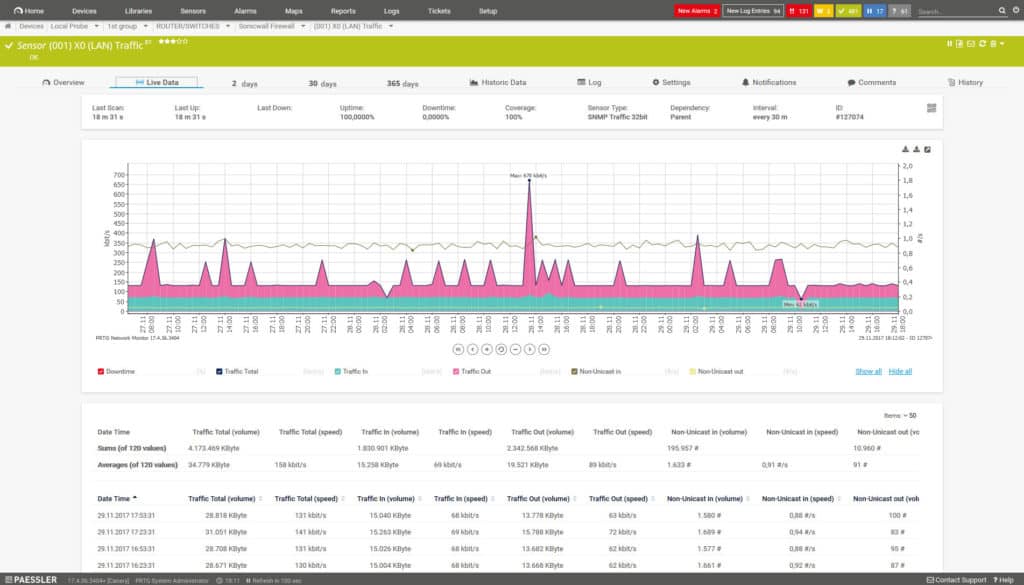
Another formidable network monitoring product is Paessler PRTG Network Monitor. This tool has climbed to be one of the top network monitoring tools in the world on account of its fast-paced design and variety of features. Network autodiscovery with PRTG Network Monitor allows you to scan devices connected to your network by IP range. Scanning the network in this way means that you don’t have to manually configure everything from scratch.
Key features:
- Network, server, and application monitoring
- Autodiscovery of connected devices
- Alerts on status errors
Why do we recommend it?
Paessler PRTG Network Monitor is one of the leading IT system monitoring services in the world. By careful planning, any business can organize requirements to get this system for free. The PRTG package is actually a bundle of many monitors, which are called sensors. You pay for the number of sensors that you want to turn on. If you only use 100, you never have to pay anything. Sensors will discover, map, and monitor any network and also has wireless network monitoring capabilities.
PRTG Network Monitor includes network, traffic, application, and cloud monitoring so that you can stay on top of current developments. The user interface is on the whole very clear-cut and while some displays can be confusing, once you’ve become acclimatized to the product this isn’t too big an issue. The health of your infrastructure is color-coded and can be displayed in dials and graphs so that you see how well everything is performing.
Who is it recommended for?
PRTG is a good option for any type of business. The free allowance of 100 sensors doesn’t stretch very far. However, businesses that are prepared to pay for more sensors get a well-planned system for monitoring networks, servers, and applications. It is also able to monitor remote sites and the internet connections between locations.
Pros:
- Drag and drop editor makes it easy to build custom views and reports
- Supports a wide range of alert mediums such as SMS, email, and third-party integrations into platforms like Slack
- Supports a freeware version
Cons:
- Is a very comprehensive platform with many features and moving parts that require time to learn
One of the biggest attractions of PRTG Network Monitor is its flexible pricing structure. There is a freeware version of PRTG Network Monitor that supports up to 100 sensors. If you need more than 100 sensors you can download 30-day free trial.
Paessler PRTG Network Monitor
Download Free Tool for up to 100 sensors
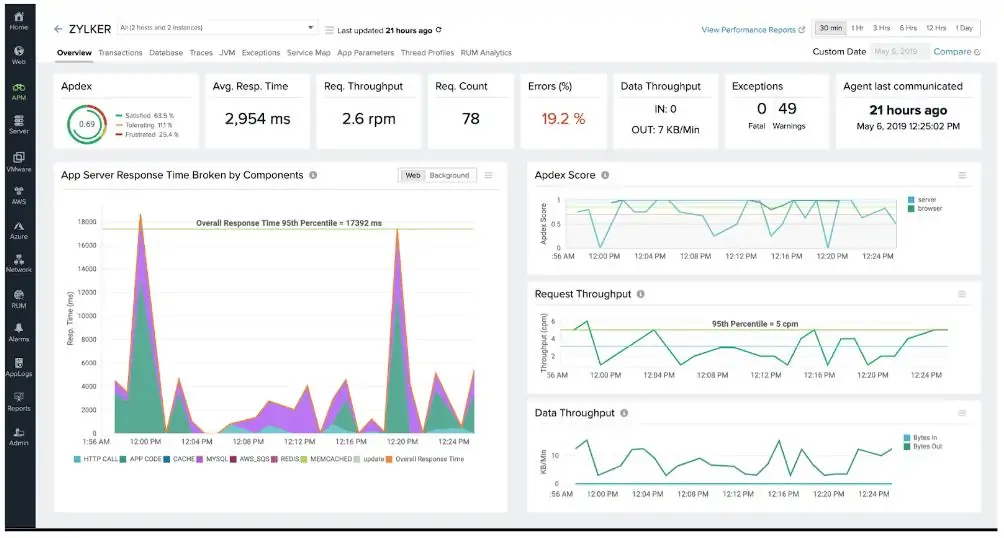
Site24x7 is a cloud-based system monitoring platform. It includes several plans and one of those, Site24x7 Infrastructure monitors servers, networks, applications, and websites. This is available in a free version.
Site24x7 Server Monitoring Free Edition has considerably fewer functions than the paid version. The functions are limited to monitoring just five servers and the abilities of the service are cut down to server uptime and response time monitoring.
Key features:
- Uptime monitoring for five servers
- Provides availability logs over time
- Calculates availability percentages
Why do we recommend it?
Site24x7 Server Monitoring is part of a platform of monitoring systems that are hosted in the cloud. The platform is accessed by subscription to a plan and all plans include the Server Monitoring option. You can add plug-ins to the Server Monitoring tool to get insights into the options of specific software or hardware brands. You can also get network and application monitoring included in your plan. Site24x7 has a special plan for monitoring websites that also includes server monitoring.
As the Site24x7 system is based in the cloud, it just needs to ping the nominated server in order to execute this function, it does not require any agent to be downloaded onto those servers.
The paid version of Site24x7 Infrastructure has a lot of useful features. It has an extensive Network Monitor that examines device status, monitors traffic volumes, logs all devices in an inventory, and generates a network topology map. The service can monitor server resource utilization and virtualizations. It also monitors applications and websites.
Who is it recommended for?
Site24x7 Server Monitoring and its companion monitoring tools provide full-stack observability, which makes it a good choice for any size or type of business. The monitoring system is based in the cloud, so it can monitor multiple servers in different locations. There is also an MSP version available.
Pros:
- Flexible cloud-based monitoring option
- Offers a host of out-of-box monitoring options and dashboard templates for SQL server
- Allows administrators to view dependencies within the application stack, good for building SLAs and optimizing uptime
- Offers root cause analysis enhanced by AI to fix technical issues faster
- Can unify SQL monitoring across multi-cloud environments
Cons:
- Site24x7 is a feature-rich platform with options that extended beyond databases management, may require time to learn all options and features
You can download Site24x7 Server Monitoring Free Edition from the Site24x7 website. However, there is a way to use the full Site24x7 system for free. This is by accessing the 30-day free trial that Site24x7 offers on the paid plan.
Site24x7 Server Monitoring Free Edition
Start FREE Edition
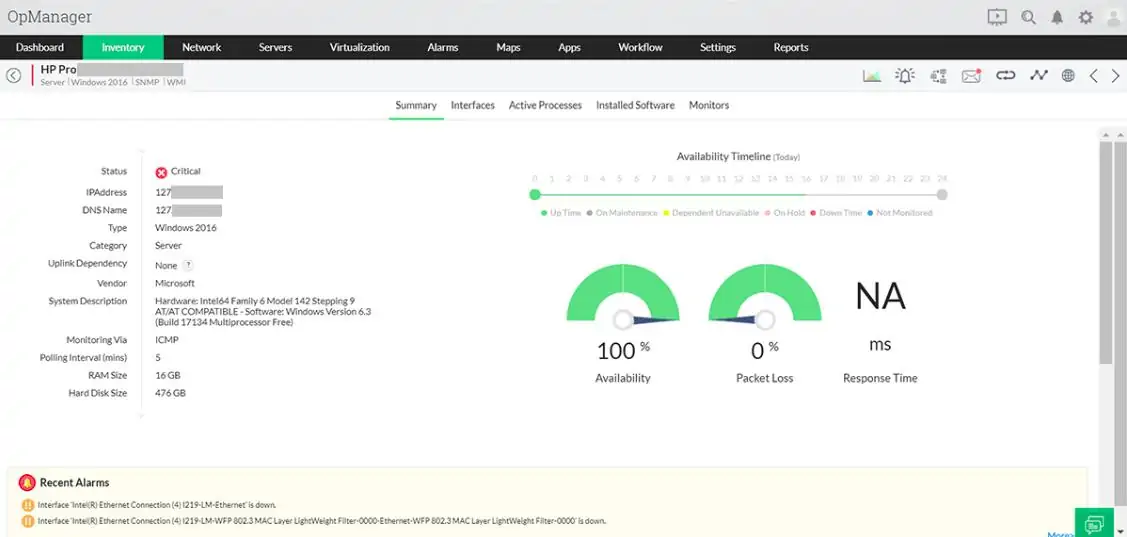
ManageEngine OpManager monitors network devices and physical servers. It is available for free and there are also high plans available for a fee.
The network monitoring capabilities of OpManager follow the classic network performance monitoring service model. It tracks the conditions of network devices by querying each piece of equipment through the Simple Network Management Protocol (SNMP). The service starts monitoring with an autodiscovery function. This uses both Ping and SNMP routines to identify all network devices and other equipment attached to the network. It then creates a device inventory from that information. This is a recursive system and so any changes you make to the network infrastructure automatically get reflected in adjustments to the network inventory. The service also automatically draws up a network topology map.
Key features:
- Network and server monitoring
- Autodiscovery of all connected devices
- Alerts on device problems
Why do we recommend it?
ManageEngine OpManager provides a great combination of scopes – networks and servers. This package is also good for tracking the performance of virtualizations. There is a Free edition available for this package, but it is limited to monitoring three devices. The lowest paid tool is very reasonably priced. However, the next edition up, called Professional offers much better value for money because it is where you get virtualization monitoring, database monitoring, and Web server monitoring, on top of the network and server monitoring systems in the Standard edition at a price that is not much higher.
The system gets all model information from each device and also receives performance statistics. The types of information that each device sends include CPU and memory utilization and available storage space. These metrics are also tracked for servers.
Network traffic statistics showing volumes of data passing through each interface on each network device are also gathered by OpManager. Device statuses and traffic performance are all shown live on the dashboard of OpManager, which interprets these statistics into color-coded graphs and charts.
All metrics have performance thresholds placed on them and if any of these are crossed, the system generates an alert. Each device is also able to send the monitor a status alert if it has an issue developing. These alerts are shown on the dashboard and they can also be forwarded to technicians as notifications by email or SMS.
Who is it recommended for?
Any size of business would benefit from using OpManager. The lower paid editions are very affordable to monitor 10 devices, which is an ideal package for a small business. The redeployment options for this tool give a large audience an option to use the package. It will run on Windows Server or Linux and it can be run on the AWS and Azure cloud platforms. ManageEngine also offers an MSP version.
Pros:
- Designed to work right away, features over 200 customizable widgets to build unique dashboards and reports
- Leverages autodiscover to find, inventory, and map new devices
- Uses intelligent alerting to reduce false positives and eliminate alert fatigue across larger networks
- Supports email, SMS, and webhook for numerous alerting channels
- Integrates well in the ManageEngine ecosystem with their other products
Cons:
- Is a feature-rich tool that will require a time investment to properly learn
The Free edition is limited to monitoring three devices. The Standard edition is able to monitor 1,000 devices and it is suitable for monitoring one site. The Enterprise edition has even greater capacity and it is able to unify the monitoring of networks on many sites. You can get a 30-day free trial of the Standard and Enterprise editions. OpManager installs on Windows Server and Linux.
ManageEngine OpManager
Limited Free Edition
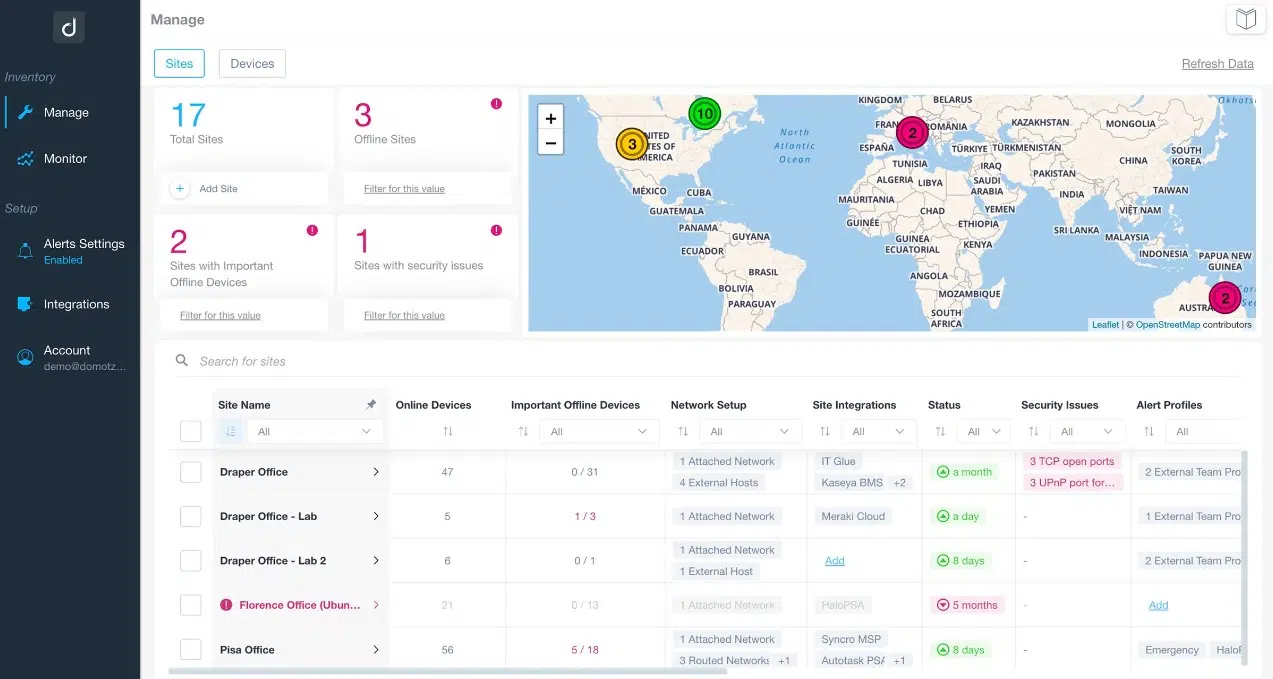
Domotz is a SaaS platform that can monitor any network anywhere. This service isn’t free forever, but you can try it out for free for 14 days. You can enroll multiple networks into one account and get overviews of the entire multi-site system plus a drill-down for each LAN. The Domotz platform downloads an agent onto a server on each site.
Key features:
- Consolidated monitoring of multiple sites
- Automatic device discovery
- LANs, VLANs, and wireless networks
Why do we recommend it?
Domotz quickly creates a network map and writes up an inventory that details the attributes of each device that it encountered. This discovery and documentation process is continuous and so all changes to the network will be automatically recognized in the system. This is a SaaS package, so you don’t need to host it. It will perform automated performance monitoring across your network and raise an alert if a problem is detected.
The Domotz system sets itself up. The agent installation can be implemented remotely and this tool can be used in a multi-tenanted account structure, making it ideal for use by managed service providers. Within each sub-account, it is possible to enroll multiple sites.
The tool uses SNMP to explore the network, discover all devices, and create a network inventory, The network scanning repeats continually, keeping the inventory up to date. The Domotz service also draws up a live network topology map per site and shows all sites on a map of the world. SNMP also provides performance monitoring that will raise an alert if a device reports a status problem. Monitored metrics can also have performance thresholds set up on them and they will also trigger alerts.
Who is it recommended for?
This is a time-saver package because it sets itself up and then runs its monitoring cycle without any human intervention. As long as there are no problems on the network, you don’t have to do anything.
Pros:
- Automated monitoring
- Continuously updated network inventory
- Live performance monitoring through SNMP
Cons:
- The free trial is only 14 days
As this is a cloud-based service, you don’t need to worry about operating system compatibility. You can access the system console from anywhere through any standard Web browser. Domotz is available for a 14-day free trial.
Domotz
Start 14-day FREE Trial
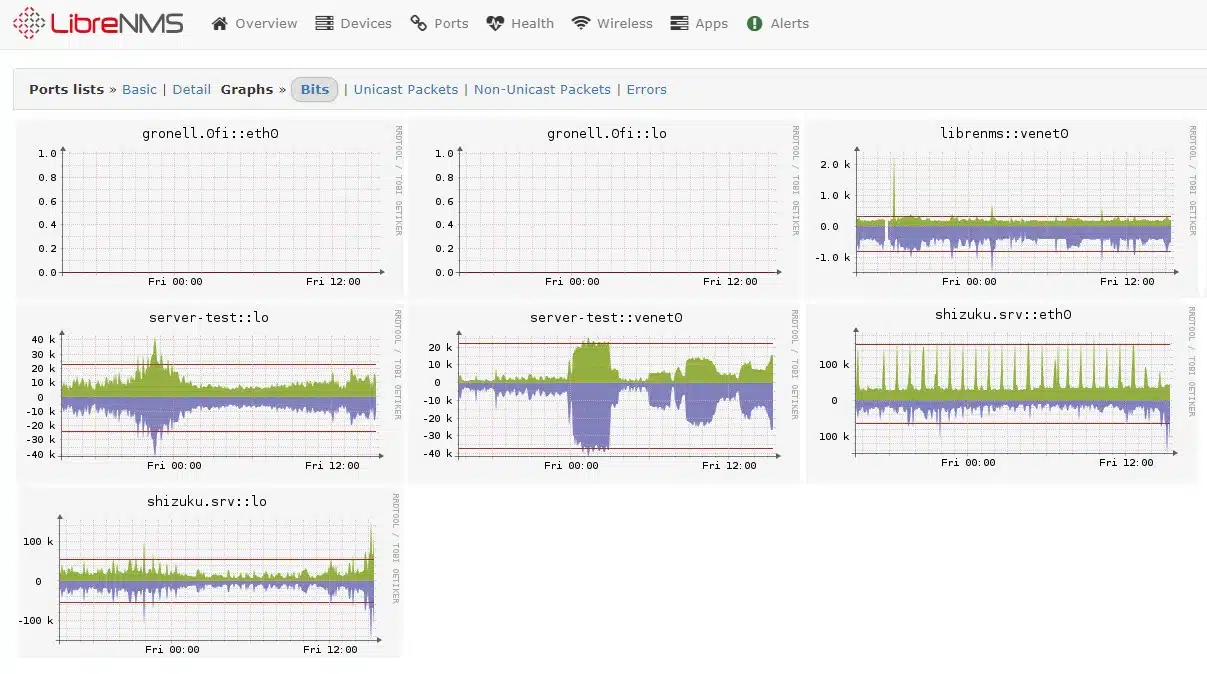
LibreNMS provides network monitoring for free and it includes an autodiscovery. Unfortunately, the wonders of the LibreNMS system don’t extend to the creation of network topology maps but it does assemble a network inventory.
Key Features:
- Network discovery
- Network inventory
- Performance alerts
Why do we recommend it?
The first reason that LibreNMS makes it onto this list is that it is free to use. The second feature that recommends this tool is that its autodiscovery system creates a chance to properly organize and track network assets. This is a good first step for a network that is not properly documented to come under automated management.
The ongoing activity monitoring services of LibreNMS provide time series graphs of live statistics, such as Ping responses from all devices. Once the basic service has been set up, you can learn to add in more detail by connecting other data sources into the monitoring tool.
Every statistic that the tool gathers can have thresholds placed against them. If these formulas are matched, the LibreNMS package will generate an alert, drawing the m=network manager to an issue that needs to be dealt with.
An unusual feature of LibreNMS that the big-name monitoring tools do not have is a billing mechanism that records throughput on each device port, which enables company accountants to allocate costs to different departments.
Who is it recommended for?
Major corporations require professional support for the software that they use and this isn’t available with LibreNMS. The tool also lacks some of the necessary features that the managers of complicated larger networks would need, such as a network topology map. So, the LibreNMS package is aimed at small businesses.
Pros:
- Documents a network
- Provides live performance statistics
- Can be expended and customized
Cons:
- No network topology map
- No professional support
The LibreNMS software is available for Linux and it can also be run over Docker.
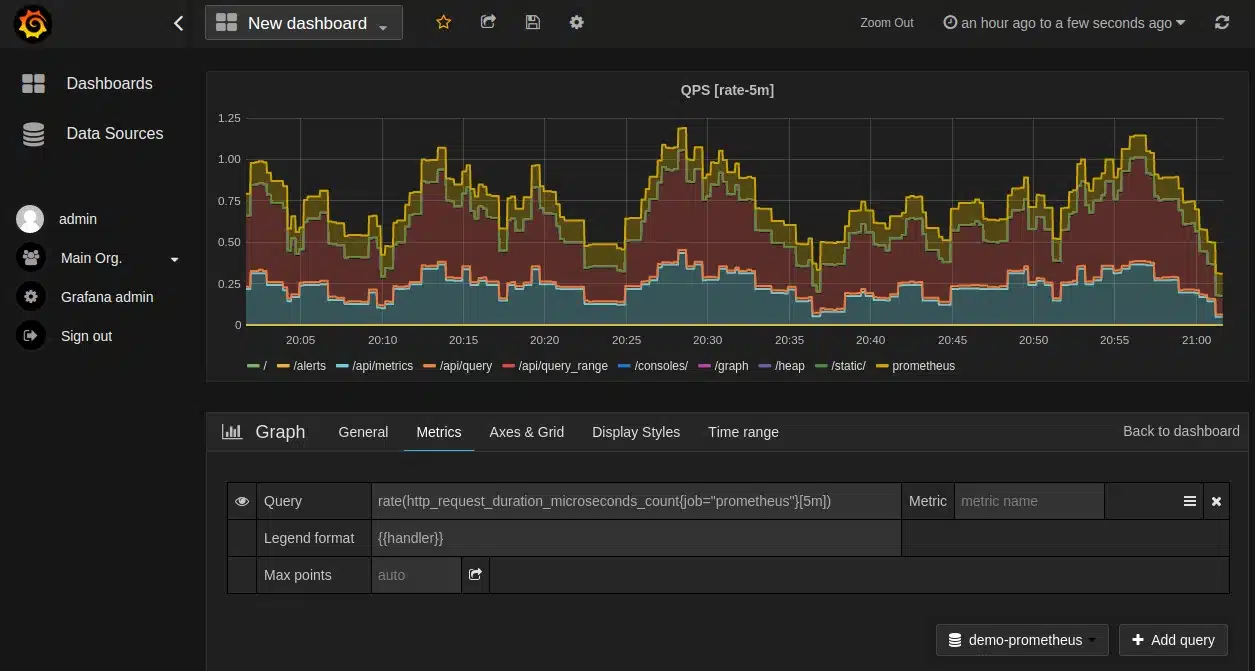
Prometheus is a free data management tool that can be used to sort through any data sources to produce time-series data streams or performance calculations. The system can be used for a range of business needs, including network monitoring. However, the system is complicated to set up.
Key Features:
- Flexible package
- Create alerts
- Data analysis
Why do we recommend it?
If you can master the proprietary data analysis language of Prometheus, which is called PromQL, you have a powerful method to create live monitoring packages for any system. This tool can be used for marketing analysis, cost tracking, and many other business applications.
Prometheus connects to other free tools in order to create a monitoring system. For example, the illustration for this review is actually a screenshot of Grafana, which is frequently used as a front end for Prometheus-based systems.
The ability to calculate statistics within the PromQL system provides an alerting mechanism. APIs in Prometheus enable the package to channel alert messages through to third-party systems, such as Slack and email systems.
Who is it recommended for?
Given the flexibility of Prometheus, it can be put to many uses. The tool could give a lot of value to large corporations that have the budget to allocate to training up developers who can create custom applications from the tool. Small businesses would benefit from the tool is an owner-manager or an under-occupied network manager is able to acquire the skills to exploit the capabilities of Prometheus.
Pros:
- Lends itself to the development of any type of data analyzer
- Integrates with many other free tools
- Creates custom data management systems
Cons:
- Not an out-of-the-box network monitor
Prometheus will run on Windows, Linux, and the little-known Darwin operating system.

Zabbix is considered by many to be the king of open-source network monitoring. This platform has been used by brands from Dell to Salesforce as well as countless SMEs. Zabbix offers a network and infrastructure monitoring experience that covers all the bases. You can monitor your infrastructure for high CPU and memory utilization. If you need to monitor your network performance you can also monitor network bandwidth usage too.
Key features:
- Free forever
- Network and server monitoring
- Alerts on system problems
Why do we recommend it?
Zabbix is an impressive monitoring package for networks, servers, and applications and it is completely free to use. The system can be extended by the installation of templates, which you can get in the user community. These include data-gathering tools to interface with specific software packages and devices plus widgets to place live statistics on a console screen.
This product offers a comprehensive environment through which you can conduct network, server, cloud, services, and KPI/SLA monitoring. It also offers users a healthy range of templates for popular technology providers. This includes the basic infrastructure monitoring mentioned above as well as the ability to monitor configuration changes.
Notifications and alerts are also included in the Zabbix product. You can send notifications via email, SMS, Jabber, Ez texting, or a custom script. You also have the ability to completely customize the content of your notifications. This allows you to determine the information that you send to your first point of contact. For instance, you can include details such as date and time, hostname, items’ value, trigger values, host profile, user macros, and escalation history.
Who is it recommended for?
As it is free to use, Zabbix will particularly appeal to small businesses and start ups. However, large organizations also use Zabbix, so it is suitable for businesses of all sizes and types.
Pros:
- Open-source transparent tool
- Uses both SNMP and ICMP for broader monitoring ranges
- Offers useful templates for quick insights
Cons:
- No paid support option – not ideal for large enterprise environments
In the event that no one responds to your notification, you can escalate it to another member of staff automatically. This is one of the features that make Zabbix a standout product on this list. Zabbix is available as a download for free on CentOS, Debian, Oracle Linux, Red Hat Enterprise Linux, and Ubuntu.
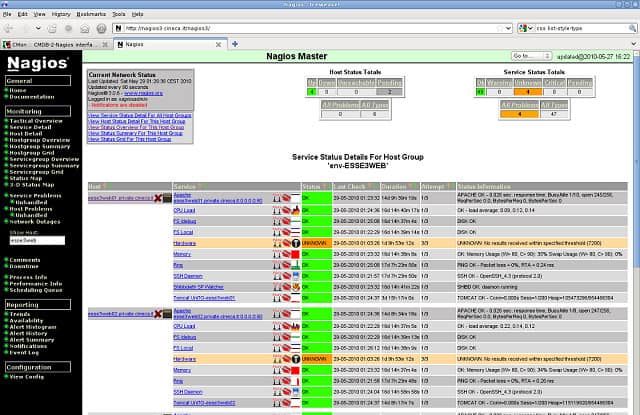
Nagios Core is one of the most-respected infrastructure monitoring products in the world. This platform is available on Windows, Linux, and VMware and allows you to monitor your network activity meticulously. It has a web-based GUI that allows you to view the health of your network infrastructure and key services. The user interface strips back the unnecessary detail in favor of a back-to-basics design.
Key features:
- Network, server, and application monitoring
- Extensible with thousands of free monitoring
- Large and active user community
Why do we recommend it?
Nagios Core is an excellent package and it is the definitive open-source system monitoring software. The big problem you will face with Nagios Core is that its interface is very rudimentary, so most users pair it up with a third-party front end – Kibana is a good choice for this. The Nagios team recently greatly reduced the appeal of both Nagios Core and its paid counterpart, Nagios XI by removing all network traffic monitoring functions out into a separate paid tool.
Infrastructure health is color-coded so that you can tell at a glance if there is a problem. This is particularly useful in summary views. You can view summary views on host status and service status to see which elements are up and running. Devices and services are marked as Up, Down, Unreachable, or Pending. You can also view more general overviews with displays such as the Top Alert Producers window which shows you all the devices that have triggered alerts that could warrant a response.
The user interface is not only easy-to-use but is also supported by configuration wizards. These wizards take you through a variety of processes such as autodiscovery and bulk host cloning so that you don’t get lost along the way. This is particularly useful for newer users who are unsure of how everything works.
Who is it recommended for?
The fact that this tool is free to use and provides comprehensive network device, server, and application monitoring features makes it a winner with businesses of all sizes. If you don’t have any interest in tinkering to get a system to work properly, you might be put off by the fact that you need to work out how to pair it up with another tool to get a front end. If you do like customizing your own system, you will love the massive library of free plug-ins that are available to extend this monitoring service’s capabilities.
Pros:
- Simple, yet informative interface
- Flexible alerting options support SMS and email
- A wide range of community designed plugins are available for free
Cons:
- The open-source version lacks the support found in paid products
There are two versions of Nagios Core available as a free download. As your network’s needs increase, you may want to consider the paid editions: the Standard Edition and the Enterprise Edition. The Standard Edition provides you with custom dashboards, summary reports, notification escalations, and configuration wizards. The Enterprise Edition is available for $3,495 (£2,708) and adds capacity planning reports, audit logging, and web-based server console access to the mix as well. You can also download the 60-day free trial.
Related post: Nagios vs Zabbix

Icinga 2 is a network monitoring product that is brought to you by the same people that brought you Nagios. In many ways, Icinga 2 replicates the features that made Nagios successful while adding a few extra ingredients. One of the distinct differences is the use of a RESTful API. With the RESTful API you can change configurations at a rapid rate in addition to interacting with your dashboard. The RESTful API combined with the ability to run thousands of checks per second makes this one of the best tools for working in a fast-moving environment.
Key features:
- Free forever
- Accepts Nagios plug-ins
- Monitors networks, servers, and applications
Why do we recommend it?
Icinga 2 offers a solution to the biggest problem that most users have with Nagios Core in that it has a Web-based front-end module, which you can choose to use or ignore and access a different system, such as Kibana. The tool also includes traffic monitoring services out of the box. Like Nagios Core, Icinga 2 is free to use.
As with all top-of-the-line network monitoring tools Icinga 2 has its own alerting system. You receive notifications through email and text when a performance issue has been flagged. You can not only select your first point of contact but you can also establish an escalation chain in case the initial recipient doesn’t respond. This ensures that there is always someone on hand to respond to new problems.
Visualization is another feature where Icinga 2 delivers a solid experience. You can take Graphite metrics (a monitoring tool for hardware and cloud services) and display them in the host/service detail view. These graphs are neatly designed which makes them easy to read on the fly. The result is a monitoring experience that allows you to put your finger on the trends as they occur.
Who is it recommended for?
If you really want Nagios but wish it included traffic monitoring and a front end, then Icinga 2 is made for you. This system is completely compatible with Nagios and will take Nagios plug-ins. Businesses that won’t use software that doesn’t come with professional support can subscribe to a support center service offered by the Icinga team.
Pros:
- Can be configured via GUI or DSL, making it a good choice for admins who enjoy CLI tools
- Supports built-in visual reporting
- Modules allow for different functionality, keeping the base installation sleek and lightweight
Cons:
- Designed for more technical users
- Better suited for smaller environments
Given that Icinga 2 came from the heritage of the team behind Nagios, it is no surprise that this is a top-of-the-range product. While the RESTful API’s CLI is a little complicated to get your head around after the learning curve, it is not too much of a problem. Icinga 2 is available for Debian, RHEL, SLES, Windows, Ubuntu, Fedora, and OpenSUSE. Icinga 2 can be downloaded for free.
Deciding on a free network monitoring tool
As you can see there is plenty of choices when it comes to high-functioning network, server, and application monitors. Whether you’re an SME that needs to add a little more scrutiny to your network monitoring or a large enterprise that needs to have the possibility of upscaling future infrastructure, there is a platform out there for you.
Our top picks for SMBs on this list are SolarWinds ipMonitor Free Edition and Paessler PRTG Network Monitor.
SolarWinds ipMonitor Free Edition stands out as the best network monitoring tool because it provides an experience that is streamlined from start to finish. You’re aided with an easy-to-use Startup Wizard that leads straight into an autodiscovery feature. Once you’re in a position to monitor your network, the user interface makes that easy to do without running into any hiccups.
Paessler PRTG Network Monitor offers an analytical lightweight approach to network monitoring that allows users to see which devices are up or down at a moment’s notice. You don’t need to mess around with fancy displays or complex navigation trees in order to find the information you need.
Both these products are accessible to smaller enterprises and epitomize the modern network monitoring experience that has become so familiar. If you’d rather go the open-source route then Zabbix is also a welcome alternative. It offers excellent out-of-the-box templates and support along with a robust alerts system.
Is PRTG Network Monitor Free?
Usually, you would have to pay for PRTG but there are two ways to get it for free. The first of these is the Free plan, which lets you use up to 100 sensors without having to pay. The second option is to take the PRTG 30-day free trial. This gives you access to all the sensors in the PRTG package. If you decide not to pay at the end of the trial period, the software keeps working, but as the Free version with only 100 sensors.
Is Spiceworks Network Monitor Free?
Spiceworks used to provide an ad-supported Network Monitor for free. However, this has now been replaced by the online Connectivity Dashboard, which is also free to use.
Is Nagios XI free?
Nagios XI is not a free tool. However, you can get it on a 30-day free trial. The Nagios XI code is based on the free, open-source Nagios Core, which is free. The great thing about Nagios is the large library of free plug-ins that it has available and these work equally well in both Nagios XI and Nagios Core.















![Toni Kroos là ai? [ sự thật về tiểu sử đầy đủ Toni Kroos ]](https://evbn.org/wp-content/uploads/New-Project-6635-1671934592.jpg)


